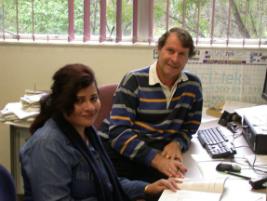Still hope for one of Australia's most severely polluted rivers
Published on 12 July, 2007

Shamsa Syeda discusses her project with her supervisor Professor David Midmore of CQU's Centre for Plant and Water Science. A Central Queensland University researcher says there is still hope for rehabilitation of one of Australia's most polluted rivers.
Since the 1890s, acid run-off and solid waste from the Mt Morgan open cut gold mine site in Central Queensland have contaminated the Dee River, destroying over 40km of natural stream ecosystems.
Over time, these contaminants built up behind 3 historic concrete dams that were constructed in the Dee River during the late 19th century to supply water to the mine.
These dams and trapped contaminated sediment were subsequently removed as part of the Dee River Dams Remediation Project undertaken by the former Department of Natural Resources and Mines in 2004.
Shamsa Syeda, from CQU's Centre for Plant and Water Science and supervised by its Director, Professor David Midmore, is in the final stages of an investigation into the impacts of heavy metal and acid mine drainage pollution from the mine site into the Dee River. The project focuses on the aquatic system that is adjacent to and downstream of the disused mine.
The assessment, which began in February last year and is due for completion in August this year, has examined each ecological compartment of the Dee River system separately but not in isolation.
"The Dee River is still severely polluted especially close to the mine site in Mt Morgan. The river is highly polluted up to 20km i.e. Fletcher Creek and Dee River confluence beyond which water quality improves under base flow condition. The area assessed downstream up to 43km in Dululu was also found polluted," Miss Syeda explained.
"We could not find a single fish and single algae at the site close to the mine site because of pollution intensity. The assessment also revealed high metal content in the river".
"We found many different metals in water, soil, fish and plants. There is no good quality of fish and plant life".
Despite Ms Syeda being surprised at the extent of the pollution in the river, she still believes rehabilitation was an option.
She will experiment with phytoremediation for the rehabilitation of the river later in the year. Phytoremediation is one of the cheapest options of rehabilitation using hyper accumulating plants to clean polluted sites and is a technique developed by CQU's Centre for Plant and Water Science.
The Department of Mines and Energy (formerly Natural Resources and Mines) will also be using techniques such as lime dosing to treat contaminated water in the former open cut pit. A lime dosing water treatment plant costing more than $3.4 million has been built at the mine site by the Department. The objective is to treat acidic water from the open cut pit and release the treated water to the Dee River in order to reduce the risk of overflow.
The research undertaken by CQU is expected to advance scientific knowledge regarding Australian freshwater fish, macroinvertebrates and plants in general and in particular, species of that biota, which are abundant in the Dee River. It also hopes to improve understanding of the lethal effects of these toxic pollutants in biota inhabitant of the Dee River system.
Caption: Shamsa Syeda discusses her project with her supervisor Professor David Midmore of CQU's Centre for Plant and Water Science.

